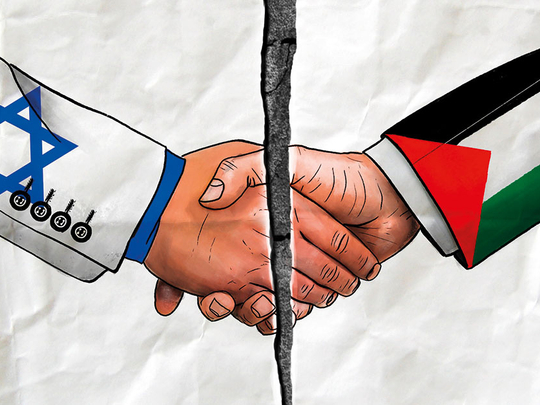
It is ironic that 25 years after the historic handshake between Palestine Liberation Organisation (PLO) chairman Yasser Arafat and the then Israeli prime minister Yitzhak Rabin and the subsequent signing of an interim agreement that was negotiated in secret in Oslo, Norway, we now find ourselves marking the symbolic death of the two-state solution. What was embraced by both parties, under American sponsorship, on September 13, 1993, on the White House lawn, is all but gone — erased by a series of events that had derailed the peace process and reversed whatever gains had been achieved.
Today, we face a strikingly different reality: Permanent occupation of most of the West Bank, a failing Palestinian National Authority (PNA) that was to be a temporary administrative body delivering full Palestinian independence by 1999, an Israel that is ruled by the most far-right government since its inception, a besieged Gaza Strip under the tight grip of hardline Palestinian groups and a United States president who is not shy to demonstrate his bias in favour of an extremist Israeli agenda.
It is also ironic that the 25th anniversary of Oslo coincides with the recent US decision to close the PLO office in Washington — thus underlining the bitter fact that after a quarter of a century we had come full circle. Moreover, under US President Donald Trump, who had promised to strike an ultimate deal between Israel and the Palestinians, the foundations of what should have constituted a final-status agreement have been knocked down one after the other, beginning with his decision last year to recognise occupied Jerusalem as Israel’s united capital and the more recent assault on the United Nations body responsible for millions of Palestinian refugees. The US administration is on its way to erase the “right of return” from future deals as well as downsizing the number of Palestinian refugees to few hundred thousand.
But this is now. The question is how did we end up here? What went wrong after the signing of the historic deal in Washington in 1993?
The reality is that extremists on both sides succeeded in scuttling the peace process almost immediately. Yossi Beilin, who initiated the secret negotiations with Mahmoud Abbas in Oslo in 1992, blames violence on both sides. It began with the horrific Hebron massacre of 29 Muslims by a Jewish colonist in February 1994, followed less than a year later by the assassination of Rabin at a peace rally by an extremist Jew.
Rabin’s death dealt a heavy blow not only to the peace process, but also to Israel’s Left that supported a negotiated settlement with the Palestinians. The Israeli Left never recovered. In May 1996, right-wing and Oslo opponent Benjamin Netanyahu won a surprising victory as Prime Minister against Rabin’s peace partner Shimon Peres. His triumph was partly driven by a series of suicide attacks carried out by Hamas and other radical groups against mostly Israeli civilian target in retaliation for the Hebron massacre. Israel’s mood for peace was changing and the Israeli Right used every occasion to incite the public against Arafat and his support of terrorist groups.
Both sides accused each other of violating the agreement. Israel continued to build illegal colonies in the West Bank, while the Palestinians were accused of failing to stop suicide attacks against Israelis. The trust that was built between the two sides had dissipated. A last-ditch effort to reach a final deal between the two sides was attempted by former US president Bill Clinton in Camp David in July of 2000. Arafat and the then Israeli prime minister Ehud Barak failed to reach an agreement. Israel blamed Arafat for missing a historic opportunity.
The second Palestinian Intifada in September 2000 was an important milestone in Oslo’s failing chances. The Israeli right-wing was now in control under Ariel Sharon and he initiated a number of steps to reverse what was agreed upon in Washington, such as building the Separation Wall, reoccupying most of the West Bank and besieging Arafat and concluding a unilateral withdrawal from Gaza.
Arafat’s death has brought little change in the trajectory of the conflict. Successive US administrations have put little effort to pressure Israel into honouring what was left of Oslo. The two-state solution has become an empty cliche as Israel pushed to colonise more Palestinian lands while blaming Palestinian President Abbas for refusing to negotiate.
Beilin believes Israel had erred in negotiating an interim agreement rather than a permanent one back in Oslo. He believes both sides should have seized the historic moment by concluding a final deal back then. But that is history. Now what remains of Oslo can hardly be recognised. Occupation is permanent and mutual coexistence is almost impossible. Despite Israel’s far-right’s effort to dismantle the Palestinian cause, the reality is that what was possible and fair 25 years ago is now more of a Gordian knot — a conundrum that neither Netanyahu nor Trump can finally resolve.
Osama Al Sharif is a journalist and political commentator based in Amman.









